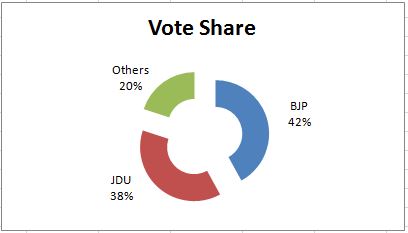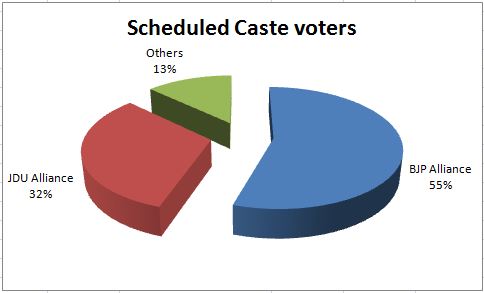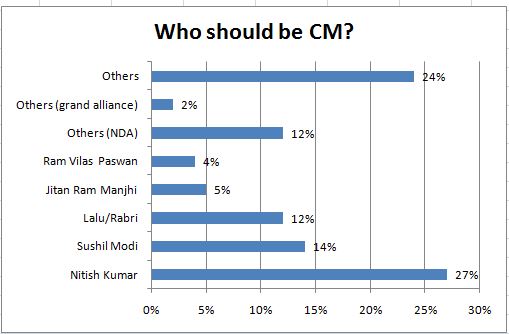Indian Express Bihar opinion Poll 2015, Bihar opinion Poll 2015, Lokniti-CSDS The Indian Express Bihar opinion Poll 2015, Bihar Latest Opinion Poll October, Opinion poll Bihar assembly elections, Who will win bihar elections 2015, Post Alliance Opinion Po
- Details
- Category: Bihar Political News
- Last Updated: Wednesday, 07 October 2015 14:53
Indian Express Bihar opinion Poll 2015, Bihar opinion Poll 2015, Lokniti-CSDS The Indian Express Bihar opinion Poll 2015, Bihar Latest Opinion Poll October, Opinion poll Bihar assembly elections, Who will win bihar elections 2015, Post Alliance Opinion Poll bihar Vidhan Sabha, Who is the best CM candidate Bihar, Bihar Opinion Exit Poll NDA BJP
A week before the first vote is cast in Bihar for the assembly elections, the BJP-led NDA seems to have a definite advantage over the Maha Gathbandhan or the Grand Alliance led by Nitish Kumar.
The findings of a pre-poll survey conducted in the last week of September by Lokniti-CSDS, exclusively for The Indian Express, indicate that the BJP alliance is poised to surge ahead of the Maha Gathbandhan by a margin of at least four per cent.
Our survey suggests that if the election had taken place in the last week of September, the NDA would have got 42 per cent votes and the Grand Alliance would have ended up with 38 per cent.
| Alliance | Vote Share |
| BJP | 42% |
| JDU | 38% |
| Others | 20% |
The Third Front led by Samajwadi Party and Pappu Yadav do not seem to be making any impact, not even as a serious ‘vote-katwa’ (spoiler). The Left parties and BSP seem to be on further decline. Asaduddin Owaisi’s MIM hardly seems to be making any impact but it is likely that through the campaign, it may pick up some Muslim votes.
Is there a pattern?
The support the two alliances are getting has a very clear social profile: Expectedly, the NDA is supported by upper castes, lower OBCs and sections of Dalits, mainly the Paswan community.
In contrast, the Grand Alliance is heavily dependent on support of the Yadavs, Kurmi-Koeris and Muslims. Besides this social divide, a spatial divide also characterises this election.
The NDA seems to be taking a huge lead over the Grand Alliance in the urban areas while the Grand Alliance is giving a tough fight to the NDA in rural constituencies.
In the urban constituencies, the NDA lead over the Grand Alliance amounts to 20 percentage point while in the rural constituencies it only has a slender lead of 2 percentage points.
The Grand Alliance seems to be doing well in the Tirhut, Mithila and the eastern Seemanchal regions, while the NDA has a huge lead over the Grand Alliance in Bhojpur and Magadh regions
Why is the Grand Alliance trailing?
As we mentioned in our earlier analysis on these pages (IE, September 16), the arithmetic on paper looks good for the Grand Alliance but it may not necessarily get translated into reality.
The NDA has a huge lead over the Grand Alliance among Scheduled Caste voters (55 per cent against 32 per cent). Even among the Grand Alliance core constituency of Yadavs, Kurmis and Koeris, two among every ten voters are supporting the NDA. This leaves the Grand Alliance with limited support among its own assured voters.
| Scheduled Caste voters | |
| Alliance | Vote Share |
| BJP Alliance | 55% |
| JDU Alliance | 32% |
| Others | 13% |
This includes the Muslims as well — the Grand Alliance is supported by about 52 per cent Muslims in the pre-poll survey and 39 per cent Muslims are choosing an option beyond the two alliances.
The ‘grand’ nomenclature of Grand Alliance apart, its partners are not bringing much value addition. While the Congress is restricted to only a few urban pockets, the RJD might turn out to be a burden.
The BJP’s campaign about Lalu Raj being a Jungle Raj seems to have gained support among common voters, damaging the prospect of the Grand Alliance. Nitish Kumar, who remains ahead of all other leaders in popular rating for Chief Minister, is almost left alone to pull votes for the alliance. His personal appeal may not prove enough.
Why is NDA ahead at this moment?
On the other hand, the BJP alliance has a natural advantage — it has been in power only for 18 months; something known as the honeymoon period is still around.
Narendra Modi is popular, and moreover, sizeable numbers of voters seem to support the view that the same party being in power at the Centre and the state will be helpful for the development of the state. BJP’s alliance partners, particularly Paswan and Manjhi, appear to be drawing support from SCs for the NDA.
Almost half of lower OBCs support the NDA. Most of all, the unprecedented polarisation of upper castes (almost 80 per cent) in its favour strengthens the NDA quite considerably.
This combination of upper caste and lower OBCs plus Dalits makes the NDA support much more balanced in class terms as well. NDA draws 40 per cent support from the lower half of the economic ladder and 46 from the upper half.
In contrast, the Grand Alliance gets only 30 per cent vote in the upper half but fails to get more than 42 per cent among the lower half.
Who should be CM?
| Who should be CM? | |
| Candidate | Vote share |
| Nitish Kumar | 27% |
| Sushil Modi | 14% |
| Lalu/Rabri | 12% |
| Jitan Ram Manjhi | 5% |
| Ram Vilas Paswan | 4% |
| Others (NDA) | 12% |
| Others (grand alliance) | 2% |
| Others | 24% |
Limits of BJP’s advantage In a prolonged and multi-phase election, ‘news’ about who is leading in a certain region does affect the political mood in regions voting later.
Though in Bihar, the floating voters are not very large in numbers right now, they would be affected by bandwagon effect if other regions are understood to have supported a particular coalition. With a four percentage point of difference, the NDA should comfortably sail ahead.
But some caveats need to be entered to make the picture complete. First, respondents have indicated their preference when they did not know the candidates.
Given the micro-management of caste factor that is adopted these days, candidate selection acquires much significance.
Two, BJP’s and NDA’s support, though handsome, is too concentrated in urban constituencies and particular regions. So, the figure of 42 per cent can be misleading in the sense that those votes may not necessarily add further to the seats the NDA may win. Three, a bitter campaign is shaping up only now. It might sway the voters either way.
Ten per cent respondents have said that they might change their current choice. Among pro-NDA respondents, such ‘probable changers’ are 12 per cent and among respondents favouring Grand Alliance they account for 8 per cent. So, the pre-poll trends should be seen only for what they are – trends, not as outcomes.





